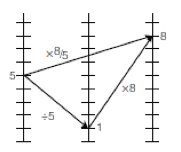Scaling - Mental Activities
Use these short mental activities to develop pupils’ confidence in using the language of scaling to describe changes in the sizes of numbers made by using multipliers expressed in equivalent forms (fractions, decimals and percentages). This will support developing understanding of the effect of reciprocal and inverse scaling as well as help with fluency in describing and approximating scaling effects.
Why use these mental activities?
To provide frequent, regular opportunities refreshing and refining pupils’ mental skills in using scaling as part of proportional reasoning.
There are three sets of teaching activities, accessible from the following links:
1. Higher / Lower
Use this activity to provide a context for application of knowledge about whether using a given fractional multiplier (scale factor) will make a number higher or lower than its original value. There is an opportunity to consider the effect of using the reciprocal of a multiplier.
2. Equivalent lists
For a given ratio p:q, ask pupils to express the multiplier (scaling factor) as a fraction or decimal and identify the percentage change. Use this context to ask for the same information for the linked inverse ratio. This is a good opportunity to discuss how percentage increase and decrease can be expressed as a single multiplier.

3. About
Use this quick-paced activity to ask pupils to approximate the result of using a given multiplier (scaling factor), expressed as a fraction or decimal. Also ask pupils to apply knowledge of scaling to describe the approximate the effect of given scaling factors, e.g. scaling by 2/5 is slightly less than halving.